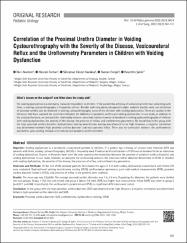Correlation of the Proximal Urethra Diameter in Voiding Cystourethrography with the Severity of the Disease, Vesicoureteral Reflux and the Uroflowmetry Parameters in Children with Voiding Dysfunction
Künye
Akarken İ, Tarhan H, Karakuş SC, Cengiz N, Şahin H. Correlation of the Proximal Urethra Diameter in Voiding Cystourethrography with the Severity of the Disease, Vesicoureteral Reflux and the Uroflowmetry Parameters in Children with Voiding Dysfunction. J Urol Surg, 2023;10(2):107-111.Özet
Objective: Voiding dysfunction is a commonly encountered problem in children. If a patient has a history of urinary tract infection (UTI) and presents with fever, voiding cystourethrography (VCUG) is frequently used. Proximal urethra dilatation in VCUG was determined to be an indication of voiding dysfunction. Studies in literature have been the ones assessing the correlation between the presence of proximal urethra dilatation and voiding dysfunction. In our study, however, we analyzed the relationship between the proximal urethra diameter determined in VCUG of children with voiding dysfunction, the severity of the disease, the presence of reflux, and uroflowmetry parameters.Materials and Methods: Of the 522 VCUG-received patients 96 between the ages of 6-8 with voiding dysfunction concomitant with febrile UTI were evaluated. Dysfunctional voiding incontinence scoring (DVIS), uroflowmetry parameters, post-void residual measurements (PVR), proximal urethra diameter noted in VCUG, and presence of reflux in the patients were analysed.Results: The mean age was 7.2 & PLUSMN;0.66. The average proximal urethra diameter was 7.6 & PLUSMN;1.8 mm. Regarding the diameter, the patients were divided into two groups: Group 1 (7.6 mm and below) and group 2 (above 7.6 mm). DVIS was higher but vesicoureteral reflux (VUR) was lower in group 2 (p=0.017, p=0.008; respectively). For uroflowmetry parameters and PVR, no significant differences were noted.Conclusion: In the group with the high-proximal urethra diameter, DVIS was observed to be high. However, a negative correlation was determined between high-proximal urethra diameter and VUR.


















